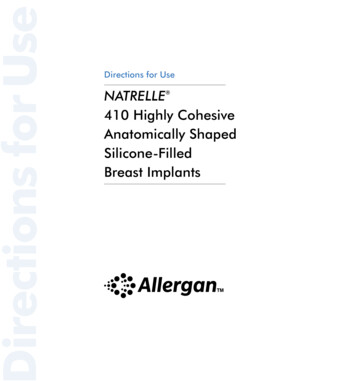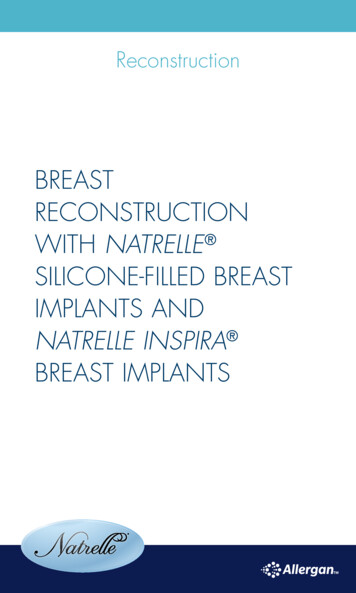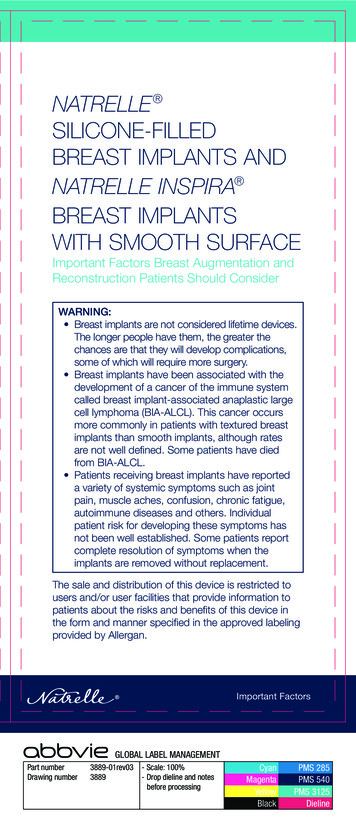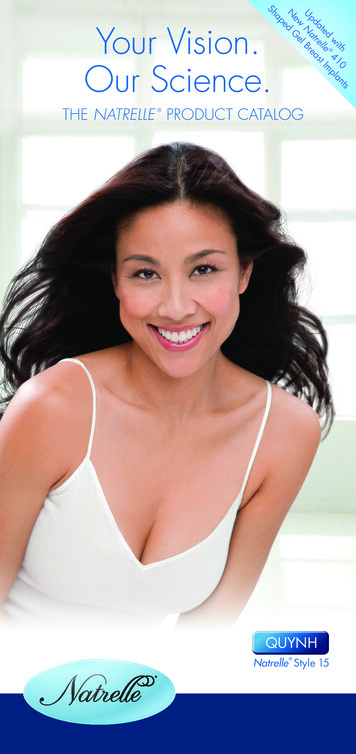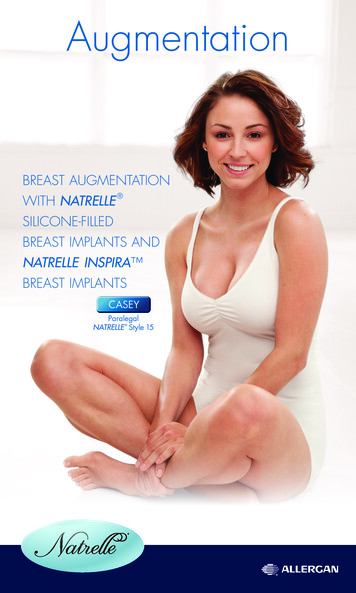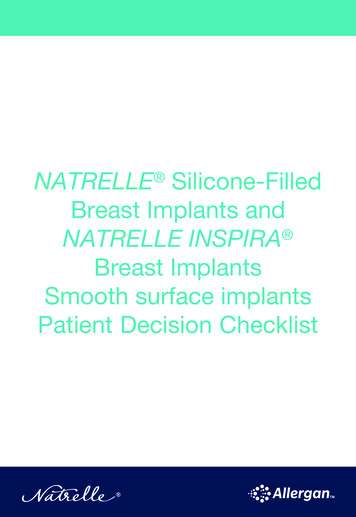
Transcription
NATRELLE Silicone-FilledBreast Implants andNATRELLE INSPIRA Breast ImplantsSmooth surface implantsPatient Decision Checklist
2
To the patient considering breast implants filled with saline or siliconegel intended for breast augmentation or breast reconstruction:The review and understanding of this document is a critical stepin making the decision whether you should choose breast implantsurgery. You should learn about breast implants and then carefullyconsider the benefits and risks associated with breast implantsand breast implant surgery before you make that decision. Thisform lists important risks, including those known or reported to beassociated with the use of the device based on information fromclinical trials, scientific literature, and reports from patients whohave undergone device placement.This Patient Decision Checklist is intended to supplement theadditional patient information documents that should be providedto you by your physician. You should receive patient informationdocuments that include important information about your specificbreast implant, as well as a boxed warning and Patient DecisionChecklist. After reviewing the information in the patient informationdocuments for the specific implant that will be used, please readand discuss the items in this checklist carefully in consultationwith your physician. You should place your initials in the locationprovided next to each item to indicate that you have read andunderstood the item. Your full signature at the end of this documentconfirms that you have read the materials and that your physicianhas answered all questions to your satisfaction.1
Considerations for a Candidate for SuccessfulBreast ImplantationI understand that I am not a candidate for breast implants if any ofthe following situations applies to me: I have an active infection anywhere in my body; I have an existing cancer or pre-cancer of my breast tissue thathas not been adequately treated; or I am pregnant or nursing.I understand that if I have any of the following conditions, I may beat a higher risk for a poor surgical outcome: Medical condition that affects my body’s ability to heal (e.g.,diabetes, connective tissue disorder); Active smoker or a former smoker; Currently taking drugs that weaken the body’s natural resistanceto disease, such as steroids and chemotherapy drugs (e.g.,prednisone, tacrolimus, sirolimus, mycophenolate, azathioprine,cyclosporine, methotrexate, chlorambucil, leflunomide, orcyclophosphamide); History of chemotherapy or planned chemotherapy followingbreast implant placement; History of radiation therapy or planned radiation followingbreast implant placement; Conditions that interfere with wound healing or blood clotting(e.g., hemophilia, von Willebrand disease, factor V Leiden,hyperhomocysteinemia, protein C deficiency, antithrombin IIIdeficiency, or systemic lupus erythematosus); or Reduced blood supply to the breast tissue.I understand the following conditions have not been adequatelystudied to determine whether the conditions put me at higher risk: Autoimmune disease (e.g., Hashimoto’s, Lupus, RheumatoidArthritis) or family history of autoimmune disease (breast implantpremarket clinical studies have not evaluated the safety ofbreast implants in patients with autoimmune disease); Clinical diagnosis of depression or other mental health disorder(including body dysmorphic disorder or eating disorder); or Have other products permanently implanted in the breast.Patient Initials:2
Risks of Breast Implant SurgeryI understand that there are risks of undergoing breast implantsurgery. I understand that risks of undergoing breast implant surgerymay include: breast pain (reported in up to 11.7% of patients1), skin or nipple areola sensitivity changes or loss (nipplecomplications reported in up to 6.3% of patients1 and breast/skinsensation changes reported in up to 2.2% of patients1), asymmetry (reported in up to 23.2% of patients1), impact of aging or weight change on size and shape of breast(ptosis reported in up to 4.9% of patients1), infection requiring possible removal of implant (reported in up to3.2% of patients1), swelling (reported in up to 9.2% of patients1), scarring (hypertrophic scarring reported in up to 6.6%of patients1), fluid collections (seroma) (reported in up to 6.7% of patients1), hematoma (reported in up to 2.1% of patients1), tissue death of breast skin or nipple (tissue/skin necrosisreported in up to 2.3% of patients1), inability to breast feed (lactation complications reported in up to30% of patients1), complications of anesthesia (may occur but specific rates arenot publicly available in the Allergan Core Study), bleeding (may occur but specific rates are not publicly availablein the Allergan Core Study), chronic pain (may occur but specific rates are not publiclyavailable in the Allergan Core Study), damage to surrounding tissue, such as muscle, nerves, andblood vessels (may occur but specific rates are not publiclyavailable in the Allergan Core Study), and impact on imaging of breast tissue (may occur but specific ratesare not publicly available in the Allergan Core Study).1 Based on the largest complication rate reported in the Core Clinical Study through 10-yearsof follow-up. See Section 5.0 of either the Breast Augmentation or Reconstruction with NatrelleSilicone-Filled Breast Implants and Natrelle INSPIRA Breast Implants with Smooth SurfacePatient Brochures.3
My physician has discussed these risks and has provided me withthe patient information documents (including the boxed warning)with information on the types of risks that are possible andexpected rates of occurrence.My physician has discussed the potential use of other implantedproducts during my breast implant surgery. My physician has alsodiscussed the risks and benefits of using these implanted productsand their planned surgical approach.Patient Initials:Risk of Cancer - Breast Implant-AssociatedAnaplastic Large Cell Lymphoma (BIA-ALCL)I understand that breast implants are associated with thedevelopment of a type of cancer of the immune system calledBreast Implant-Associated Anaplastic Large Cell Lymphoma(BIA-ALCL). Information regarding the number of medical devicereports of BIA-ALCL can be found on FDA’s website.2As of July 2019, literature reports various estimates for theincidence of BIA-ALCL. These estimated incidence rates range froma high of 1 per 3, 817 patients to 1 in 30,000. (Clemens et al, 2017,Loch-Wilkinson et al, 2017, De Boer et al, 2018).I have received information regarding the overall incidencerates of BIA-ALCL and the rates as they pertain to my specificbreast implant.I understand that this cancer has been reported more frequentlyfor textured breast implants, but patients with smooth surfacedimplants have also been diagnosed.I understand that patients with breast implants have a risk ofdeveloping BIA-ALCL within the scar tissue and fluid surroundingthe breast implant.2 See “Medical Device Reports of Breast Implant-Associated Anaplastic Large Cell Lymphoma,”available at anaplastic-large-cell-lymphoma.4
I understand that BIA-ALCL typically takes several years to developafter implantation, but cases have been reported as early as withinone year. Typical symptoms to be aware of may include: breasttightness, pain, lumps, or swelling of the breast months or yearsafter I receive my implants.I understand that treatment for BIA-ALCL involves an operationto remove the implants and the surrounding scar tissue capsule.Based on the stage of the cancer at diagnosis, some patientshave required chemotherapy or radiation. While BIA-ALCL typicallyresponds well to therapy, some patients have died from BIA-ALCL.Diagnosis and treatment may be at my own expense and is notalways covered by insurance.Patient Initials:Systemic SymptomsI understand that some patients who have received breast implantshave reported a variety of systemic symptoms including joint pain,fatigue, rash, memory loss, and “brain fog” that some patientshave called breast implant illness. While the causes of thesesymptoms are unclear, some patients have reported relief of thesesymptoms with removal of their implants and surrounding scarcapsule; however, not all patients may experience improvement intheir symptoms. Researchers are working to better understand thepossible link between breast implants and these symptoms.I also understand that some patients with breast implants havereported health problems in their children after birth or breastfeeding.A causal link has not been established between breast implants andthese reported health problems in children and more research isneeded. I understand that breast implants and breast surgery mayinterfere with my ability to successfully breastfeed.Patient Initials:5
Breast-Implant Specific RisksI understand that a breast implant is NOT a lifetime device andthe longer I have my implants, the more likely I am to experiencea complication and the more likely I am to need a reoperationrequiring the replacement or removal of my breast implant. As manyas 32.4% of women who received breast implants for augmentationhad their implants removed within 10 years, but my implants maylast for a shorter or longer period of time. (The percentage reportedis from the 10-year Core Clinical Study for Natrelle Silicone gel-filledbreast implants. The rate specified represents the largest reportedcumulative 10-year rate across all groups of augmentation patientsin the study (both primary and revision)).I understand that my breast implant may rupture or leak at anytime, and that the longer I have my implants, the more likely I amto experience a complication such as rupture. I understand thatgel bleed (small quantities of gel diffusing from the implant shell) ofsilicone gel-filled implants may occur. I understand that if I have asaline-filled implant, my breast may deflate in appearance if there isa rupture or leakage of the saline.I understand that if I have a silicone gel-filled breast implant, I orthe physician may not be able to tell on physical exam whether myimplant has ruptured or is leaking silicone gel. Because rupture orleakage of silicone gel-filled breast implants is difficult to detect,I understand that periodic imaging evaluation is recommendedfor screening of silicone gel-filled breast implant rupture. It isrecommended that I have periodic imaging of my silicone gel-filledbreast implants to screen for implant rupture regardless of whethermy implants are for cosmetic augmentation or reconstruction. Theserecommendations do not replace other additional imaging that maybe required depending on my medical history or circumstances (i.e.,screening mammography for breast cancer).Even if I have no symptoms, I should have regular imagingevaluations as described in the “Recommended Follow-Up”section below. These imaging evaluations may not detect allruptures or leaks, and the expense may not be covered by mymedical insurance.6
I understand that there are rare case reports of silicone migratingfrom breast implants into tissues (e.g., chest wall, lymph nodesunder the arm) and organs (e.g., liver, lungs). It may not be possibleto remove migrated silicone.I understand that all breast implants can affect mammographyand breast exams, which could potentially delay the diagnosis ofbreast cancer. Mammography can also cause the breast implant torupture or leak. I should tell the mammography technician if I havebreast implants.I understand that the long-term risks of breast implants may include: painful or tightening of scar tissue (capsule) around myimplant (capsular contracture III/IV) (reported in up to 28.7%of patients1), rupture or leaking of the implant (reported in up to 35.4%of patients1), wrinkling of the implant (wrinkling/rippling reported in up to10.2% of patients1), visibility of the implant edges (implant palpability/visibilityreported in up to 6.7% of patients1), shifting of the implant (implant malposition reported in up to13.3% of patients1), or reoperation (reported in up to 71.5% of patients1).I understand that I will receive a Device Identification Card aftermy surgery that has information on each of my specific implants. Iunderstand that it is important for me to keep each card in case, atsome time in the future, I or my physician need to know what kindof implant I received many years later.I understand that breast implant manufacturing requires the useof chemicals and heavy metals. I understand that most of thesechemicals stay inside the shell of the implant. Small quantities maydiffuse (gel bleed) through the implant shell of silicone gel-filledimplants, even if the implant is intact and not ruptured or leaking.A list of the components, chemicals, and heavy metals is availablein the section entitled, “NATRELLE Silicone-Filled/Saline-FilledBreast Implant Device Materials” of the patient informationdocument.Patient Initials:7
Recommended Follow-upEven if I have no symptoms, I should have my first ultrasound orMRI at 5-6 years after my initial implant surgery and then every 2-3years thereafter. If I have symptoms or uncertain ultrasound resultsfor breast implant rupture, an MRI is recommended.I understand that for as long as I have my breast implant(s), Iwill need routine and regular follow-up with my physician, forexamination of my breast implant(s) as well as to discuss anyupdates regarding breast implant issues.National Breast Implant Registry (NBIR): I understand and havediscussed with my physician that there is a National Breast ImplantRegistry where information regarding my health and breast implantinformation can be entered. The NBIR may help understand thelong-term safety and performance of breast implants.Patient Registry and Outcomes For breast Implants and anaplasticlarge cell Lymphoma (ALCL) etiology and Epidemiology (PROFILE):I understand and have discussed with my physician that thereis a registry (PROFILE) where information is collected to betterunderstand BIA-ALCL in patients with breast implants.Patient Initials:Questions for My PhysicianI have had the opportunity to ask my physician questions abouthis or her experience, medical degree, specialty of training, andcredentials. I understand that breast implants have associatedprocedural risks and should only be used by physicians who areappropriately trained.Patient Initials:8
Options Following MastectomyI understand that breast reconstruction is an elective procedure,which I can choose to do or not.I understand that I may choose not to have breast reconstruction(“going flat”) and may choose to use an external prosthesis in mybra to look like I have a breast when wearing clothes.I understand the surgical options for breast reconstruction,including the use of a breast implant and the use of my own tissue(“autologous reconstruction”).I understand that if my breast implants are ever removed, I may beleft with dimpling, chest wall concavity, puckering, or sagging of mybreasts or skin.I understand that more surgeries may be necessary in the futuredue to complications or to remove or replace the breast implants.I have discussed all of the options for breast reconstruction with mysurgeon, including whether I am a candidate and the benefits andrisks of each, and I believe that breast reconstruction with a breastimplant is the best option for me.Patient Initials:Breast Augmentation OptionsI understand that breast augmentation is an elective procedure toincrease the size of my breasts.I understand that breast augmentation may result in permanentchanges to my breast tissue and if my implants are ever removed,I may be left with an unsatisfactory appearance, changes to thesize and shape of my breasts, including but not limited to dimpling,chest-wall concavity, puckering, sagging, or different incision sizeor location.If I am an augmentation patient, any additional surgeries or medicalprocedures will likely be at my own expense.Patient Initials:9
CONFIRMATION OF DISCUSSION OF RISKSPatient: I acknowledge that I have received and read thepatient information documents for the specific implant that willbe used during my surgery and that I have had time to discussthe information in it and on this document with my physician. Ihave had the opportunity to ask questions and understand thebenefits and risks of breast implants for me, given my specifichealth conditions. I have considered alternatives to breastimplants, including reconstruction without breast implants, noreconstruction/augmentation, and their respective benefits and risks.Patient Signature and DatePhysician: I acknowledge that I have discussed the benefits andrisks of breast implants as described elsewhere in the patientinformation documents and in this checklist. I have also explainedthe benefits and risks of the alternatives. I have encouraged thepatient to ask questions, and I have addressed all questions.Physician Signature and Date10
11
Allergan Sales, LLC2525 Dupont DriveIrvine, CA 926121.800.624.4261 2021 Allergan. All rights reserved.All trademarks are the property of their respective owners.Patented. See: lwww.allergan.com74009US10 11/2021
Risks of Breast Implant Surgery I understand that there are risks of undergoing breast implant surgery. I understand that risks of undergoing breast implant surgery may include: breast pain (reported in up to 11.7% of patients1), skin or nipple areola sensitivity changes or loss (nipple
